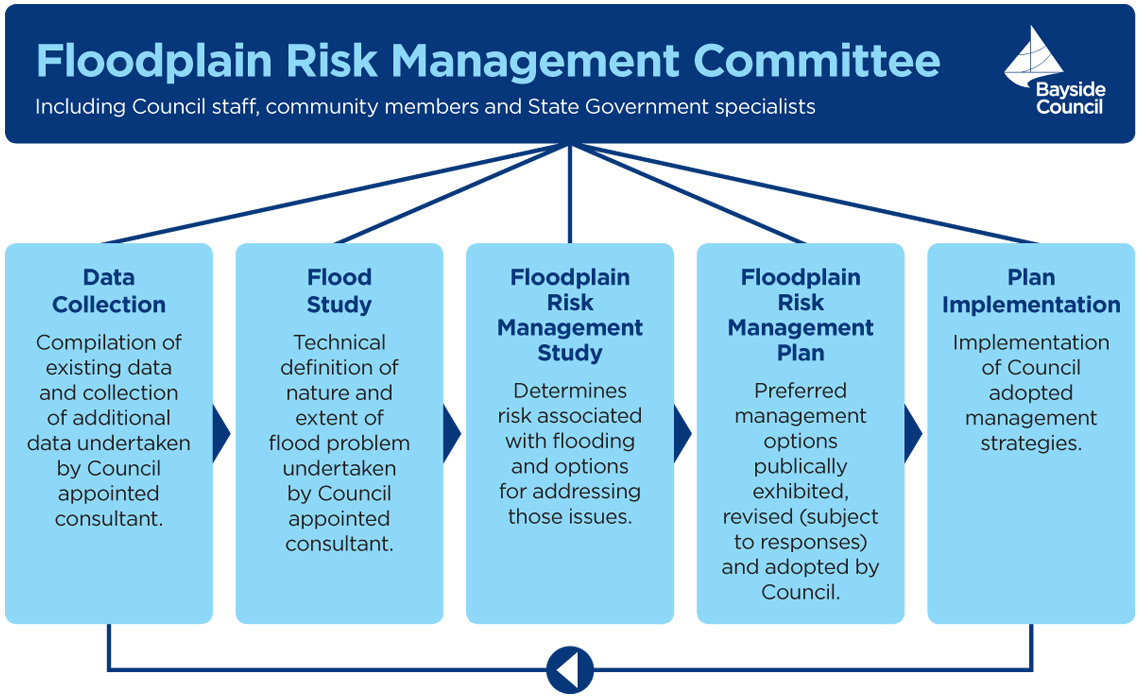Bexley High Street flood: Pictures from scene
Council uses Floodplain Chance Management Studies and Plans to outline flood mitigation measures and to reduce the hazard of flooding.Under the NSW Government's Overflowing Prone Land Policy, Quango is required to manage flooding issues and put plans into place to safeguard overflowing-prone areas.
The Floodplain Evolution Manual (2005) guides Council in the development and implementation of local Floodplain Hazard Management Plans to produce robust and effective floodplain run a risk management outcomes.
Flooding in Bayside Council
Stormwater is by and large managed by Council's stormwater drainage system of pits and pipes. However the capacity of the drainage system is sometimes exceeded, causing flooding. Flooding is defined in several unlike ways:
- Overland flooding: Intense rainfall can create excess runoff which flows overland once the chapters of the drainage organisation is exceeded.
- Tidal/oceanic flooding: Due to their low elevation, some areas of Bayside are susceptible to inundation caused past very loftier astronomical tides (i.eastward. king tides) or elevated oceanic level events (due east.yard. storm surge). The elevated tide and ocean levels cause water to back up existing trunk drainage pipes and inundation low lying areas in the catchment.
- Mainstream flooding: Intense rainfall can overflow the natural banks a creek, lake or river and flood areas side by side to the waterways.
- Major flooding can be caused when mainstream flooding, overland flooding and tidal/oceanic alluvion events coincide.
Managing Flooding
Council develops and implements Floodplain Risk Direction Plans which provide a range of measures to reduce the impact of flooding. This work is guided by the Floodplain Development Manual (2005). Creating a Floodplain Risk Management Program involves a number of stages.

The objective of the Alluvion Study is to identify the nature and extent of flooding inside a catchment. Beingness aware of the flooding potential in a catchment and identified divers reposnses, reduces the risk to life and property during inundation events.
The objective of Floodplain Risk Management Plans is to identify the existing flood environment and recommend specific measures to manage the bear on of flooding. Flood behaviour, evacuation issues and site access are all taken into consideration.
During the implementation phase, Council progressively prepares Flood Studies, Floodplain Chance Direction Studies and Plans for each catchment.
Following planning, actions are put in place. Key deportment include:
- Setting planning rules to reduce the affect of flooding from and on new developments
- Building, upgrading and maintaining stormwater structures including channels, detention basins and droppings control structures to reduce the hazard of blockage and floods.
- Purchasing eligible properties that have a high flood take chances under a voluntary purchase scheme.
- Providing flood information to the customs so informed decisions most buying or developing land can be made.
- Maintaining waterways managed past Council and encouraging other land owners to maintain their waterways.
- Planning how to answer to and recover from floods.
Community Consultation
Community consultation is an integral component of every phase of the Floodplain Take a chance Management Program process. At key stages, residents are invited to provide feedback about flooding issues and potential flood management measures. Our Floodplain Risk Management Committee also includes community representation. Acquire more about the Floodplain Risk Management Committee.
Source: https://www.bayside.nsw.gov.au/area/environment/floodplain-management
Posted by: levineingle1968.blogspot.com

0 Response to "Bexley High Street flood: Pictures from scene"
Post a Comment